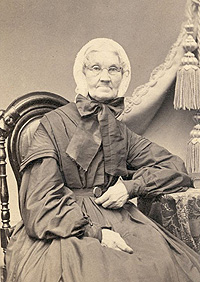John James Audubon and the Price Family of Saint John

Bogardus Galleries, New York
John James Audubon, 1785-1851
albumen print carte-de-visite
10.2 x 6.0 cm
Gift of Mary Elizabeth Blackburn Brown, 1922 (4906)
On 27 April 1863 at her home in Carmansville (later Washington Heights), New York, Lucy Bakewell Audubon gave two oil paintings to two of her neighbours, thus forging a lasting connection between a renowned American artist and a Saint John family.
Lucy Audubon (1788-1874) was the widow of artist and naturalist John James Audubon (1785-1851), who was born in Saint Domingue (Haiti), the son of a French sea captain and plantation owner. He was raised by his stepmother in Nantes, France, where he fostered an early interest in art and nature. In 1803 he left for America, where he settled on the family estate near Philadelphia, married his wife Lucy, and set about pursuing a career that combined his ornithological and artistic talents.

Bogardus Galleries, New York
Lucy Bakewell Audubon, 1788-1874
albumen print carte-de-visite
10.1 x 6.1 cm
Gift of Mary Elizabeth Blackburn Brown, 1922 (4908)
Audubon’s great masterpiece was The Birds of America, published in London by R. Havell & Son, 1827-1838. This four-volume elephant folio set achieved Audubon’s goal that the birds should be shown life size, in action and in appropriate settings. The Birds of America was a popular and lucrative success, earning Audubon a place among the great American artists of the nineteenth century.
The oil paintings were part of a project Audubon devised to promote and finance his expensive publication. He decided to create oil copies of some of the watercolours for exhibition and sale. Although he never liked painting in oil and did not think he was good at it, Audubon painted some of the oils for this project, but also, in 1831, commissioned Scottish landscape artist Joseph Bartholomew Kidd (1808-1889) to paint others. Many of these paintings survive, but it is not always clear whether the artist was Audubon or Kidd. A number of factors suggest that Kidd executed the Price family paintings.
The recipients of the paintings were Jane Eliza Blackburn Phillips Price (Cape Breton, N.S. 1813-1891 Saint John, N.B.) and her elder daughter Mary Elizabeth Price (1837-1892 Saint John). Jane Price was the widow of Edmund Allen Price (Saint John 1808-1857 Carmansville, N.Y.). Edmund Price was a merchant on the South wharf of Saint John engaged in his father’s business, the nature of which has not yet been determined. Edmund later moved to Boston and then to New York, whether for business or personal reasons is unknown. After his death in Carmansville in 1857, his family remained in New York for a time, but had returned to Saint John by the 1890s.
In Carmansville, the Prices and Audubons were fairly close neighbours, and Jane Price and Lucy Audubon were friends. Lucy’s gift to the Price women must have had special significance since at the very time it was made, Lucy was in financial difficulty leading her to have to sell Minnie’s Land, the family home, and much of her husband’s art.
The occasion of the gift was recorded by Mary Elizabeth’s younger sister Mary Dickenson S. Price (Massachusetts 1853-1914 Digby, N.S.) who was present at the time. Later, back in New Brunswick, she married Ira Cornwall Junior (1847-1897), a Saint John insurance agent. The paintings eventually passed to her and, in 1919, were donated to the Natural History Society of New Brunswick by their son, Ira Edward Cornwall. Some years later, in 1922, Mary and Ira Cornwall’s daughter Mary Elizabeth Blackburn Brown, donated four photographs, portraits of John James and Lucy Audubon, and one plate from The Birds of America, further evidence of the family connection.
There had been other direct connections between Audubon and New Brunswick. In the summer of 1832 he and his family made a voyage up the St. John River in a boat he described as “a mere scow, commanded by a person of rather uncouth aspect and rude manners.” In Fredericton they stayed with lieutenant-governor Sir Archibald Campbell, a stay he remembered very fondly. Then he proceeded up river to Woodstock and on to Houlton, Maine.
An expedition to Labrador the following year is vividly described in his journals, where he wrote, “Seldom in my life have I left a country with as little regret as this.” On the way back he stopped at Saint John, arriving at 2:00 am. Here, he walked the streets by moonlight and, when the shops opened, bought “two suits of excellent stuff for shooting garments.” On that trip Audubon also sailed the Bay of Fundy and visited Grand Manan and Point Lepreau. Could it have been during one of these visits to New Brunswick that he met the Price family in Saint John?





